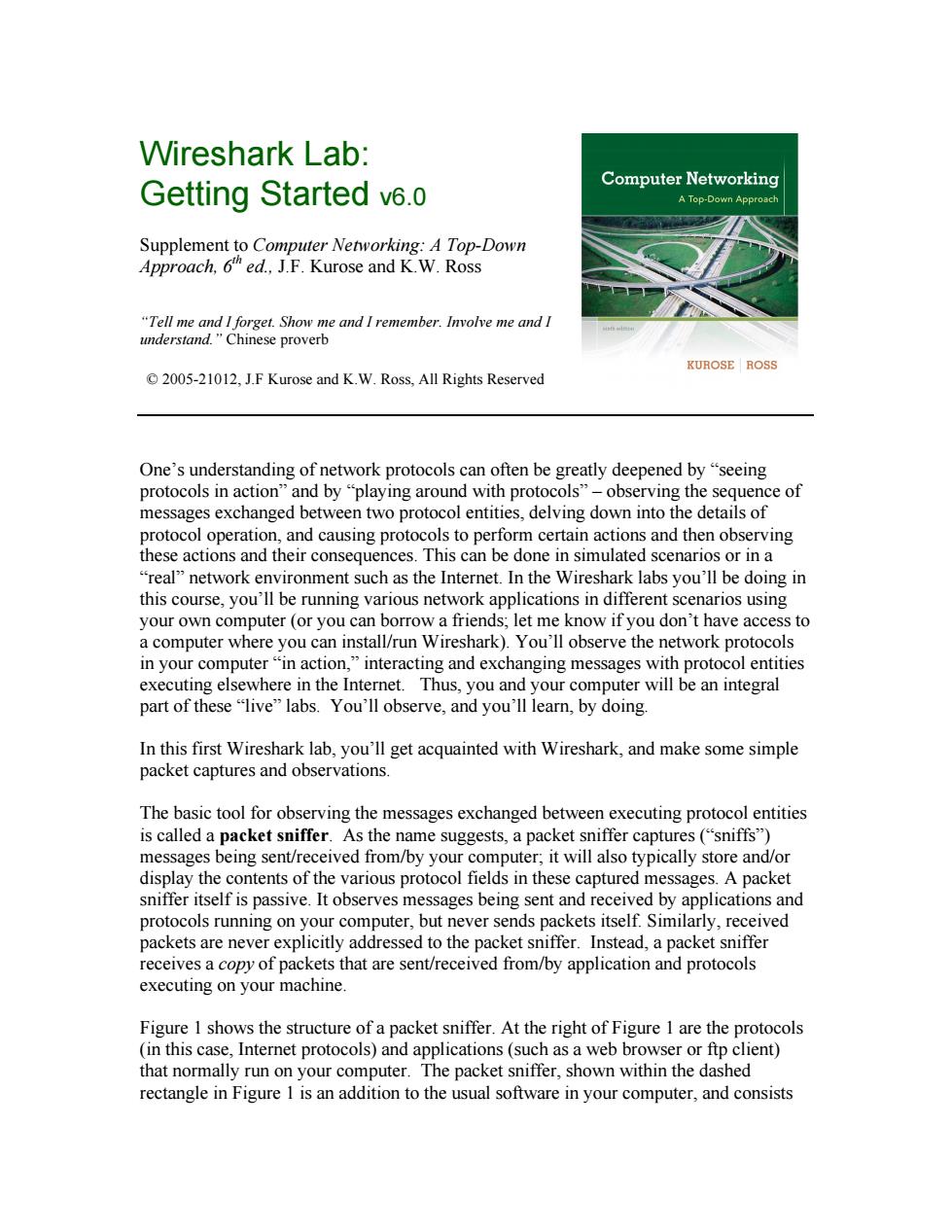正在加载图片...

Wireshark Lab: Computer Networking Getting Started v6.0 Top-Down Approach Supplement to Computer Networking:A Top-Down Approach,ed..J.F.Kurose and K.W.Ross "Tell me and I forget.Show me and I remember.Involve me andI mdersiand.Chinese proverb KUROSE ROSS 2005-21012,J.F Kurose and K.W.Ross,All Rights Reserved One's understanding of network protocols can often be greatly deepened by "seeing protocols in action"and by "playing around with protocols"-observing the sequence of messages exchanged between two protocol entities,delving down into the details of protocol operation,and causing protocols to perform certain actions and then observing these actions and their consequences.This can be done in simulated scenarios or in a "real"network environment such as the Internet.In the Wireshark labs you'll be doing in this course,you'll be running various network applications in different scenarios using your own computer(or you can borrow a friends;let me know if you don't have access to a computer where you can install/run Wireshark).You'll observe the network protocols in your computer"in action,"interacting and exchanging messages with protocol entities executing elsewhere in the Internet.Thus,you and your computer will be an integral part of these"live"labs.You'll observe,and you'll learn,by doing. In this first Wireshark lab,you'll get acquainted with Wireshark,and make some simple packet captures and observations. The basic tool for observing the messages exchanged between executing protocol entities is called a packet sniffer.As the name suggests,a packet sniffer captures("sniffs") messages being sent/received from/by your computer;it will also typically store and/or display the contents of the various protocol fields in these captured messages.A packet sniffer itself is passive.It observes messages being sent and received by applications and protocols running on your computer,but never sends packets itself.Similarly,received packets are never explicitly addressed to the packet sniffer.Instead,a packet sniffer receives a copy of packets that are sent/received from/by application and protocols executing on your machine. Figure 1 shows the structure of a packet sniffer.At the right of Figure 1 are the protocols (in this case,Internet protocols)and applications(such as a web browser or ftp client) that normally run on your computer.The packet sniffer,shown within the dashed rectangle in Figure I is an addition to the usual software in your computer,and consistsWireshark Lab: Getting Started v6.0 Supplement to Computer Networking: A Top-Down Approach, 6th ed., J.F. Kurose and K.W. Ross “Tell me and I forget. Show me and I remember. Involve me and I understand.” Chinese proverb © 2005-21012, J.F Kurose and K.W. Ross, All Rights Reserved One’s understanding of network protocols can often be greatly deepened by “seeing protocols in action” and by “playing around with protocols” – observing the sequence of messages exchanged between two protocol entities, delving down into the details of protocol operation, and causing protocols to perform certain actions and then observing these actions and their consequences. This can be done in simulated scenarios or in a “real” network environment such as the Internet. In the Wireshark labs you’ll be doing in this course, you’ll be running various network applications in different scenarios using your own computer (or you can borrow a friends; let me know if you don’t have access to a computer where you can install/run Wireshark). You’ll observe the network protocols in your computer “in action,” interacting and exchanging messages with protocol entities executing elsewhere in the Internet. Thus, you and your computer will be an integral part of these “live” labs. You’ll observe, and you’ll learn, by doing. In this first Wireshark lab, you’ll get acquainted with Wireshark, and make some simple packet captures and observations. The basic tool for observing the messages exchanged between executing protocol entities is called a packet sniffer. As the name suggests, a packet sniffer captures (“sniffs”) messages being sent/received from/by your computer; it will also typically store and/or display the contents of the various protocol fields in these captured messages. A packet sniffer itself is passive. It observes messages being sent and received by applications and protocols running on your computer, but never sends packets itself. Similarly, received packets are never explicitly addressed to the packet sniffer. Instead, a packet sniffer receives a copy of packets that are sent/received from/by application and protocols executing on your machine. Figure 1 shows the structure of a packet sniffer. At the right of Figure 1 are the protocols (in this case, Internet protocols) and applications (such as a web browser or ftp client) that normally run on your computer. The packet sniffer, shown within the dashed rectangle in Figure 1 is an addition to the usual software in your computer, and consists